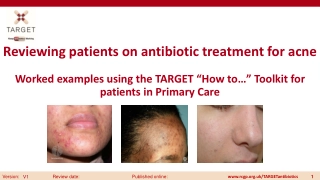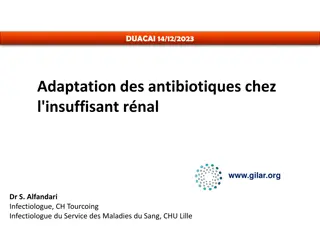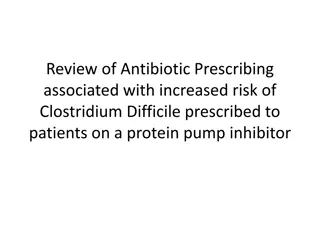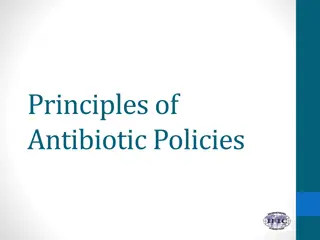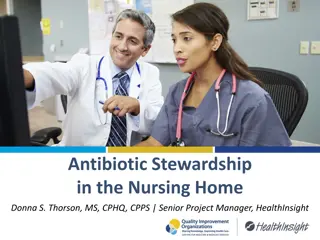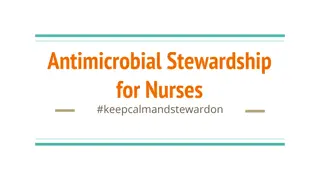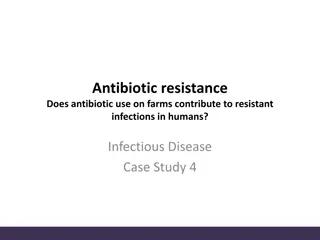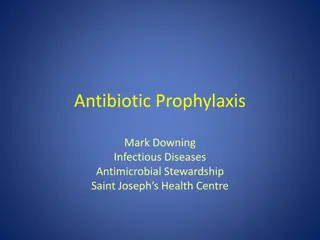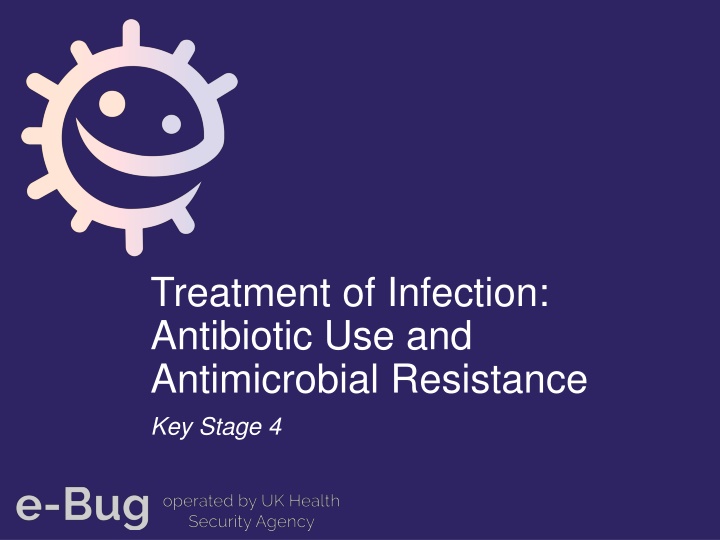
Antibiotics and Antibiotic Resistance in Infections
Explore the role of antibiotics, how they combat bacteria, the development of antibiotic resistance, and ways to prevent its spread in infections. Learn why antibiotics do not work on viruses and the importance of responsible antibiotic use.
Download Presentation

Please find below an Image/Link to download the presentation.
The content on the website is provided AS IS for your information and personal use only. It may not be sold, licensed, or shared on other websites without obtaining consent from the author. If you encounter any issues during the download, it is possible that the publisher has removed the file from their server.
You are allowed to download the files provided on this website for personal or commercial use, subject to the condition that they are used lawfully. All files are the property of their respective owners.
The content on the website is provided AS IS for your information and personal use only. It may not be sold, licensed, or shared on other websites without obtaining consent from the author.
E N D
Presentation Transcript
Treatment of Infection: Antibiotic Use and Antimicrobial Resistance Key Stage 4
Learning Outcomes All students will: Understand that antibiotics do not work on viruses, as bacteria and viruses have different structures. Understand that bacteria are continually adapting to develop ways of not being killed by antibiotics, this is called antibiotic resistance. Understand that taking antibiotics also affects your useful bacteria, not just the ones causing an infection. Understand that antibiotic resistant bacteria can be carried by healthy or ill people and passed onto others without knowing. Understand that antibiotic resistance spreads between different bacteria within our body. Understand that controlling antibiotic resistance is everyone s responsibility including you. e-Bug.eu
Curriculum Links PHSE/RHSE Health and prevention Science Scientific thinking Experimental skills and strategies Analysis and evaluation English Reading Writing Art & Design Graphic communication e-Bug.eu
What are Antibiotics Used for? Antibiotic is a type of medicine that kills or stops bacteria increasing in number. In 1928 Alexander Fleming went on holiday and left some laboratory agar plates from an unrelated experiment out on his desk. When he came back from holiday he discovered that the bacteria growing in his agar plates couldn t grow near the mould that was also growing on the plate, he concluded that the mould had produced a chemical to protect itself from the bacteria using an antibacterial agent. Scientists used this new chemical to develop antibiotics. e-Bug.eu
What are Antibiotics Used for? Before the development of antibiotics, such as during World War 2, people with injuries died from bacterial infections. Once antibiotics were being produced many deaths and diseases were prevented and surgeons were able to perform much more difficult operations, like hip replacements. Antibiotics can kill our body s useful bacteria (commensals) leaving our body open to harmful microbes (pathogens). One or two bacteria may change (mutate) so the antibiotic cannot kill them these are antibiotic resistant bacteria. Overuse and misuse of antibiotics has led to bacteria developing resistance to antibiotics through natural selection (survival of the fittest). e-Bug.eu
How Can Everyone Help to Prevent Antibiotic Resistance? Only using antibiotics when prescribed by a health care professional (HCP). Finishing your course of antibiotics as recommended by your HCP. Not using left over antibiotics (if for any reason you don t finish your course of antibiotics, any left over should be given to your local pharmacy to dispose of). Not using antibiotics for most ear aches, sore throats or any colds or flu which are usually caused by viruses. e-Bug.eu
Main Activity: Agar Experiment e-Bug.eu
Which antibiotic should be prescribed to each patient? 2. Carefully and slowly use the pipette to drop antibiotics into the appropriately labelled hole until it is filled 5. Record your findings on the worksheet 1. Place each agar plate on a sheet of white paper and label the boreholes (one per antibiotic). 4. Measure the size of the decolourised zone (if present) 3. Replace the lid on the Petri dish and leave for 5 mins e-Bug.eu
Agar Experiment Worksheet Eva is on a summer work placement at the local hospital laboratory. It is her job to read the test results and fill in the paperwork. Eva has missed up some of the test results. Her results sheet shows the following: Patient Peni- cillin Meti- cillin Erythro- mycin Vanco- mycin Amoxi- cillin Diagnosis Influenza Strep throat Staphyloco ccus wound infection MRSA Not sensitive no zone visible Sensitive no zone of growth visible She has cultured the infectious organism isolated from each of the patients on agar plates and identified the diagnosis. Can you repeat the antibiotic sensitivity test and match the patient to the results. e-Bug.eu
Antibiotic Sensitivity Test Results Patient A Patient B Patient D Patient C e-Bug.eu
Agar Experiment Worksheet: Patient A In the results section below, record the results of your sensitivity test and identify which antibiotic you would recommend the doctor to prescribe. Patient A___________________ Flu (Influenza virus) Zone of Inhibition Size (mm) Penicillin Methicillin Erythromycin Vancomycin Amoxicillin Recommended antibiotic _________________________________________________________ e-Bug.eu
Agar Experiment Worksheet: Patient B In the results section below, record the results of your sensitivity test and identify which antibiotic you would recommend the doctor to prescribe. Patient B___________________ Strep Throat (Streptococcus) Zone of Inhibition Size (mm) Penicillin Methicillin Erythromycin Vancomycin Amoxicillin Recommended antibiotic _________________________________________________________ e-Bug.eu
Agar Experiment Worksheet: Patient C In the results section below, record the results of your sensitivity test and identify which antibiotic you would recommend the doctor to prescribe. Patient C___________________ MRSA (Methicillin Resistant Staphylococcus aureus) Zone of Inhibition Size (mm) Penicillin Methicillin Erythromycin Vancomycin Amoxicillin Recommended antibiotic _________________________________________________________ e-Bug.eu
Agar Experiment Worksheet: Patient D In the results section below, record the results of your sensitivity test and identify which antibiotic you would recommend the doctor to prescribe. Patient D___________________ Staph Wound Infection (Staphylococcus aureus) Penicillin Methicillin Erythromycin Vancomycin Amoxicillin Zone of Inhibition Size (mm) Recommended antibiotic _________________________________________________________ e-Bug.eu
Agar Experiment Worksheet - Q1 1. Antibiotics don t cure the cold or flu, what should the doctor recommend or prescribe to patient A to get better? ___________________________________________ ___________________________________________ ___________________________________________ ___________________________________________ ___________________________________________ ___________________________________________ ___________________________________________ ___________________________________________ ___________________________________________ e-Bug.eu
Agar Experiment Worksheet - Q2 2. Methicillin used to be used to treat a Staphylococcal infection, what would happen to Patient C s infection if they had been prescribed Methicillin? _____________________________________________ _____________________________________________ _____________________________________________ _____________________________________________ _____________________________________________ _____________________________________________ _____________________________________________ _____________________________________________ _____________________________________________ e-Bug.eu
Agar Experiment Worksheet - Q3 3. If you had some amoxicillin left over in your cupboard from a previous chest infection, would you take them later to treat a cut on your leg that got infected? Explain your answer. _____________________________________________ _____________________________________________ _____________________________________________ _____________________________________________ _____________________________________________ _____________________________________________ _____________________________________________ _____________________________________________ e-Bug.eu
Agar Experiment Worksheet - Q4 4. Patient D doesn t want to take the prescribed flucloxacillin for their wound infection. I took more than half of those pills the doc gave me before and it went away for a while but came back worse. Can you explain why this happened? ______________________________________________ ______________________________________________ ______________________________________________ ______________________________________________ ______________________________________________ e-Bug.eu
Agar Experiment Worksheet: Patient Results Eva is on a summer work placement at the local hospital laboratory. It is her job to read the test results and fill in the paperwork. Eva has missed up some of the test results. Her results sheet shows the following: Patient Peni- cillin Meti- cillin Erythro- mycin Vanco- mycin Amoxi- cillin Diagnosis Influenza A Strep throat B Staphyloco ccus wound infection C MRSA D Not sensitive no zone visible Sensitive no zone of growth visible She has cultured the infectious organism isolated from each of the patients on agar plates and identified the diagnosis. Can you repeat the antibiotic sensitivity test and match the patient to the results. e-Bug.eu
Agar Experiment Answers: Patient A Patient A: Influenza is caused by a virus as such none of the antibiotics will have an effect as antibiotics can only be used on bacterial infections. e-Bug.eu
Agar Experiment Worksheet Answers: Patient B Patient B: Sore throat infections are quite common and generally get better on their own. In sever cases, most antibiotics will treat this infection. Penicillin is the antibiotic of choice for this infection as the group of bacteria responsible (Streptococcus) have yet to develop a mechanism of resistance. Antibiotics should not be given unnecessarily for mild sore throats as 80% of sore throats are due to viruses and other bacteria can develop resistance during treatment. e-Bug.eu
Agar Experiment Worksheet Answers: Patient C Patient C: Methicillin Resistant Staphylococcus aureus (MRSA) infections are becoming increasingly difficult to treat. These S.aureus bacteria have developed resistance to Methicillin, the previous antibiotic of choice. Vancomycin in one of the last lines of defence against these potentially fatal bacteria however some organisms have been detected with also show resistance to this. e-Bug.eu
Agar Experiment Worksheet Answers: Patient D Patient D: Penicillin was the first antibiotic discovered and produced, unfortunately many people viewed it as a wonder drug and used it to treat many common infections. This resulted in the majority of Staphylococcal bacteria quickly developing resistance to this antibiotic. As ampicillin is a derivative of penicillin, Staphylococcus bacteria are resistant to this as well. Methicillin is the drug of choice for this sensitive Staphylococcus infection. e-Bug.eu
Agar Experiment Answers Q1 1. Antibiotics don t cure the cold or flu, what should the doctor recommend or prescribe to patient A to get better? ___________________________________________ ___________________________________________ ___________________________________________ ___________________________________________ ___________________________________________ ___________________________________________ ___________________________________________ ___________________________________________ C) The doctor should prescribe antifungals. A) Antibiotics can be used to treat viral infections, the doctor should prescribe antibiotics. B) Antibiotics can only be used to treat bacterial infections; the cold or flu is caused by a virus. The doctor should prescribe medicines to help with the symptoms. e-Bug.eu
Agar Experiment Answers Q2 2. Methicillin used to be used to treat a Staphylococcal infection, what would happen to Patient C s infection if they had been prescribed Methicillin? A) Nothing. MRSA is resistant to antibiotics. B) Patient C would have gotten better; their _____________________________________________ _____________________________________________ _____________________________________________ infection would have gone away. e-Bug.eu
Agar Experiment Answers Q3 3. If you had some amoxicillin left over in your cupboard from a previous chest infection, would you take them later to treat a cut on your leg that got infected? Explain your answer. _____________________________________________ _____________________________________________ _____________________________________________ _____________________________________________ _____________________________________________ _____________________________________________ _____________________________________________ _____________________________________________ _____________________________________________ _____________________________________________ C) Yes. A) No, you should never use other people s antibiotics or antibiotics which have been prescribed for a previous infection. There are many different types of antibiotics which treat different bacterial infections. Doctors prescribe specific antibiotics for specific illnesses and at a dose suitable for that patient. Taking someone else s antibiotics may mean your infection does not get better. B) No, you should get some new medicine. e-Bug.eu
Agar Experiment Answers Q4 4. Patient D doesn t want to take the prescribed flucloxacillin for their wound infection. I took more than half of those pills the doc gave me before and it went away for a while but came back worse. Can you explain why this happened? ______________________________________________ ______________________________________________ ______________________________________________ ______________________________________________ ______________________________________________ ______________________________________________ ______________________________________________ antibiotic in future. A) Patient D should not have taken their medicine. B) Patient D should only have taken one pill. C) It is very important to finish a course of prescribed antibiotics, not just stop halfway through. Failure to finish the course may result in not all the bacteria being killed and possibly becoming resistant to that e-Bug.eu
Activity 2: Antibiotics Right or Wrong ? e-Bug.eu
Discuss Which of These Statements are Right or Wrong 1 He was coughing and sneezing everywhere. You would have thought the doctor would have given him antibiotics! 2 My doctor told me to take my antibiotics for 5 days so that is what I did. e-Bug.eu
Discuss Which of These Statements are Right or Wrong 3. When my friend was ill, I gave her my old antibiotics. I like helping my friends. 4. Antibiotics don t help coughs and colds; you just need bed rest, lots of fluids and eat healthily. e-Bug.eu
Discuss Which of These Statements are Right or Wrong 5 All drugs are bad for you. I can t see the point in taking antibiotics. 6 My doctor gave me antibiotics to take for 10 days but I feel better after 3 days so I m going to stop taking them. e-Bug.eu
Discuss Which of These Statements are Right or Wrong 7 My headache and flu symptoms are really getting me down. I think I need antibiotics! 8 I don t take antibiotics unless I really need them as they might not work in the future. e-Bug.eu
Discuss Which of These Statements are Right or Wrong - Answers Wrong Most common infections that cause coughing and sneezing are caused by viruses, and will get better by themselves with bed rest and fluid intake. Antibiotics are not effective against viruses. Right 1 He was coughing and sneezing everywhere. You would have thought the doctor would have given him antibiotics! Antibiotics should be taken exactly as advised by your healthcare professional. 2 My doctor told me to take my antibiotics for 5 days so that is what I did. e-Bug.eu
Discuss Which of These Statements are Right or Wrong - Answers Right Wrong Most common infections that cause coughing and sneezing are caused by viruses, and will get better by themselves with bed rest and fluid intake. Antibiotics are not effective against viruses. You must not use other people s or any leftover antibiotics. When my friend was ill, I gave her my old antibiotics. I like helping my friends. 4 Antibiotics don t help coughs and colds; you just need bed rest, lots of fluids and eat healthily. e-Bug.eu
Discuss Which of These Statements are Right or Wrong - Answers Wrong Antibiotics can help severe bacterial infections such as pneumonia or kidney/ urine infections. Wrong Antibiotics should be taken exactly as advised by your healthcare professional. 5 All drugs are bad for you. I can t see the point in taking antibiotics. 6 My doctor gave me antibiotics to take for 10 days but I feel better after 3 days so I m going to stop taking them. e-Bug.eu
Discuss Which of These Statements are Right or Wrong - Answers Wrong Right Antibiotics are not effective against headaches or viruses, such as the one that causes flu. If you over-use antibiotics they might not work when you really need them for a severe infection. 7 My headache and flu symptoms are really getting me down. I think I need antibiotics! 8 I don t take antibiotics unless I really need them as they might not work in the future. e-Bug.eu
Discussion e-Bug.eu
Discussion Points Antibiotics don t cure the cold or flu, what should the doctor recommend or prescribe to a patient to get better? What would happen if a patient was prescribed an antibiotic to treat a bacterial infection, but the bacteria was resistant to that antibiotic? e-Bug.eu
Discussion Points If you had some Penicillin left over in your cupboard from a previous sore throat, would you take them later to treat a cut on your leg that got infected? Explain your answer. A patient doesn t want to take the prescribed antibiotic for their wound infection. They say: I took more than half of those pills the doc gave me before and the infection went away for a while but came back worse! Can you explain why this happened? e-Bug.eu
Extension Activity e-Bug.eu
Essay Writing Write an essay based on the message from the e-Bug antibiotics animation and the common misconceptions you have learnt about during the lesson. You should consider the following points: a. What are the most common misconceptions around antibiotics and why might there be such widespread misunderstanding? b. How would tackling common misconceptions around antibiotics help to slow or prevent the rise of resistance? c. What methods or approaches should be used to tackle misconceptions? d. Personal, family or friends experiences of antibiotics can also be included, such as why antibiotics were taken and if the user thought they may have been unnecessary. What would have helped in this situation? e-Bug.eu
Learning Consolidation e-Bug.eu
Antibiotics do not work on viruses, as bacteria and viruses have different structures. True/False? True e-Bug.eu
Bacteria are continually adapting to develop ways of not being killed by antibiotics, this is called antibiotic adaptation. True/False? False, it is called antibiotic resistance. e-Bug.eu
Antibiotic resistant bacteria can be carried by healthy or ill people and can be passed on silently to others. True/False? True e-Bug.eu

